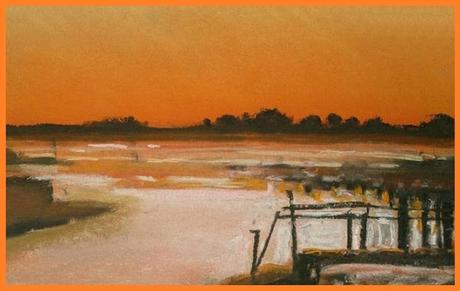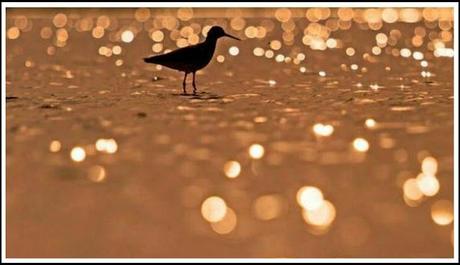We also have an estuary just to the north of Blackpool, where the Wyre flows into the Irish sea, and where from its banks one can watch the river at sunset become a flaming ribbon under those same tangerine skies, as little sandpipers flute their evening cries.

estuary at sunset
I've posted pieces about the Wyre Estuary on a few previous occasions and so I don't plan to cover that estuarine ground again. Here's a link to the earliest, from almost eight years ago, when I was relatively new to both the North West and the blogging game: Saltmarsh Blues Blog Instead I want to say a few words about those afore-mentioned sandpipers, and to leave you with a new poem. My big book of birds instructs me that there are twenty different varieties of sandpiper inhabiting the shorelines of estuaries, lakes and seas worldwide. What they all have in common is long legs for wading at the water's edge and long bills for probing into mud or sand for food, both sets of features allowing them to keep their compact bodies from getting wet. They are part of a larger group of shoreline birds known as 'waders' for obvious reasons (which comprises oystercatchers, plovers, snipe, curlews, godwits, knots, redshanks, dotterels, dunlins, phalaropes, ruffs, turnstones and whimbrels).Of the twenty varieties of sandpiper, whose adjectival qualifications include buff-breasted, green, marsh, pectoral, purple, semi-palmated, sharp-tailed, solitary, spotted, white-rumped and wood, it is the unpretentiously named common sandpiper that inhabits our north-western shorelines, and fittingly so.

solitary sandpiper?
Designated actitis hypoleucos, from the ancient Greek aktites (meaning coast-dweller) plus hupo (beneath) and leukos (white), it should come as no surprise that what distinguishes the common sandpiper is the pure white breast beneath its brownish-grey upper body. It's a relatively small bird, only about eight inches long, and it spends its days in gregarious flocks combing the tideline for insects, molluscs, crustacea or worms. As it walks, its hind parts and tail bob up and down much like a wagtail's do. When it takes to the air (often in a flock) it flies low over the water on stiff, bowed and rapidly beating wings, almost skidding across the surface. In summer, flocks of common sandpipers often put on flying displays. When it calls, it pipes with a shrill, twee series of four or five notes. All in all, a rather lovely little bird.I'll leave you with the poem, the title of which makes them sound like a notable local family, don't you think? Fylde gentry. Hambleton is on the shore of the Wyre estuary. The emission of raw sewage into Britain's rivers has increased by 87.6% in the last year and a half. Water companies have "transgressed with impunity" on no fewer than 375,000 occasions over that period. How long can this go on without causing irreparable harm to wildlife?The Sandpipers of HambletonOne with the mottling dusk they pipe in the creeping tidethat cools their feet while washing out those hieroglyphswhich told the story of their foraging. Almost unseen nowthe ceremonious bobbing in time with that kittywiper call.
Do they have souls? They seem to rejoice in the returningof the waves which bring tomorrow's feed. Or might it be
relief that salt tang and seawater will dilute the offense ofraw sewage leaked into their estuary? If they suffer from
emotional wounds, don't let the trauma taint their pipingshrill incantation to a higher avian power (for God surely
is made in bird's image). As dark brings silence once moreto Hambleton's shore, I reflect it is a thin line we all tread.
Thanks for reading, S ;-) Email ThisBlogThis!Share to TwitterShare to Facebook
